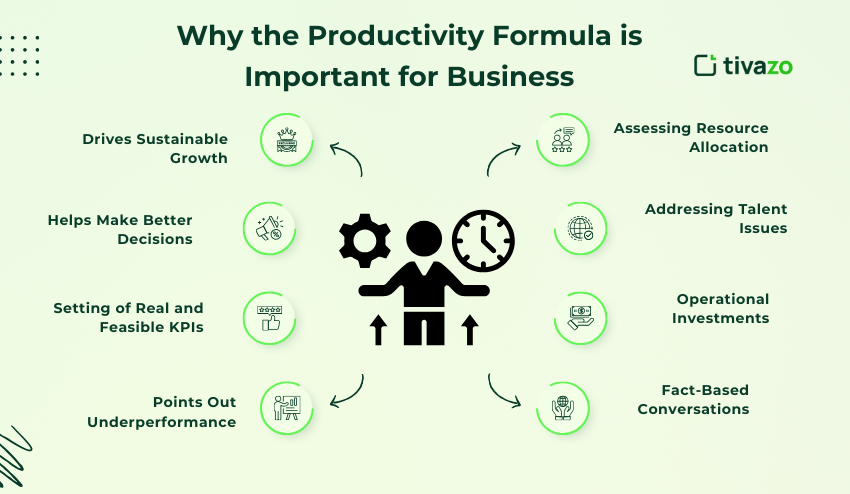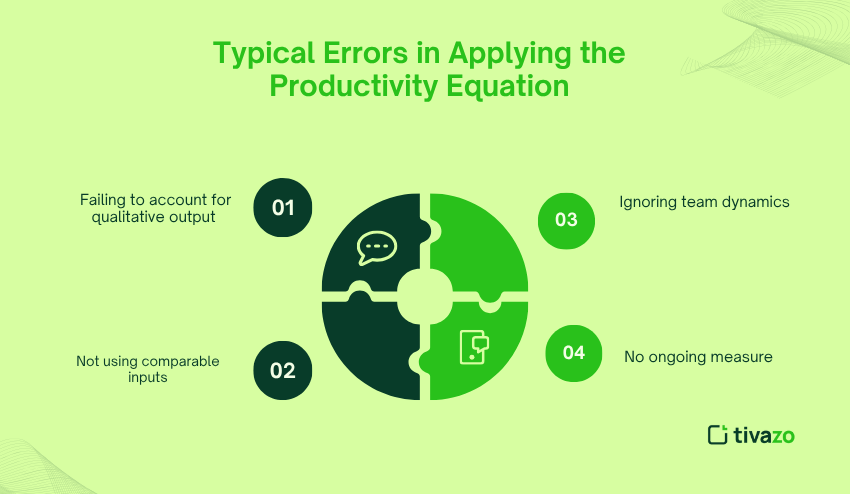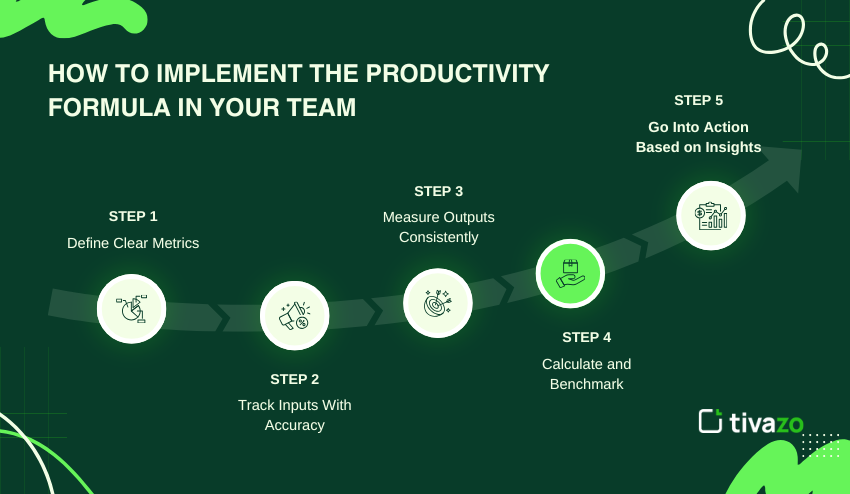As organizations become more focused on results, agility, and lean processes, the productivity formula has been cemented as a pillar of workforce analytics. No matter if you are managing a remote software team or a manufacturing floor, knowing how much output is being generated from a certain amount of input can determine whether your efficiency goals succeed or fail.
Productivity isn’t just about doing more; it is about doing smarter and reducing waste at the same time. A company producing 100 units with 10 workers is less productive than a company producing 120 units with the same 10 workers. By applying the productivity formula, leaders can uncover inefficiencies, reallocate workloads, and make decisions based on real data to improve the productivity of their teams.
At Tivazo, we build a culture of using principles of the productivity formula into all of our software every day. From automatic time reporting on everything your people are doing, to tracking the applications and behaviour of staff throughout the day, Tivazo provides organizations with valuable, accurate input-output metrics that can be captured in real-time. Simple but persuasive dashboards help you convert data into insights and set meaningful output targets, track performance, and hold your team accountable for outcomes.
The productivity formula is an important one, but it should not be viewed merely as a number. When you adopt a culture of good use of the productivity formula, you will be creating a competitive advantage. A proper use of the productivity formula can only lead to improvement in profitability, less burnout, and increased opportunity for employees.
Key Highlights:
- The Fundamental Formula of Productivity
- Understanding the System Productivity Formula
- How to Calculate Productivity Across Different Situations
- What Does 75% Productivity Mean?
- What is the formula for Productivity Ratio?
- Why the Productivity Formula is Important for Business
- Typical Errors in Applying the Productivity Equation
The Fundamental Formula of Productivity
To put it in plain terms, the fundamental formula of productivity is
Productivity = Output / Input
Where;
- Output = Total goods or services produced
- Input = Total resources consumed (time, labor, materials)
Let’s consider the example below:
A factory produces, let’s say, 200 units using 50 labor hours. Hence, we can then show the productivity formula as follows:
- Productivity = 200 units/50 hours = 4 units per hour
Meaning, the factory produces 4 units for every labor hour.
Understanding the System Productivity Formula
The system productivity formula covers everything beyond simple labor. It considers the entire production system- machines, energy, raw materials, and human effort.
- System Productivity = Total Output / Total System Inputs
This particular variant of the productivity formula finds special application in the manufacturing industries or in any large-scale operations wherein there are many inputs involved.
At Tivazo, we measure system productivity metrics by analyzing time-tracking logs, system usage, idle time, and real-time activity monitoring, making our platform ideal for companies that seek end-to-end visibility.
This system productivity formula tells businesses exactly where bottlenecks occur, or where delays or waste of assets take place. For example, if the energy consumption is too high to yield the same amount of output, inefficient machines or poor design of the workflow may be the culprit. In the same way, when output does not justify recorded work time, human resources are implicated as being poorly performing.
With Tivazo, companies can collect data of a very fine granularity spanning multiple dimensions- employee behavior, application usage, downtime, and task closure times. This data can be mapped to the system productivity formula to provide real-time insights and past comparisons, eventually driving better decisions, optimized processes, and bigger returns on operational investment.
How to Calculate Productivity Across Different Situations
As you can see, several different formulas can measure productivity in different departments and industries
1. Employee Productivity Formula
Productivity = Total Output/Total Amount of Hours Worked
This is by far the most common way to calculate how productive an employee is in a given work week. For example, if an employee completes 10 reports in 5 hours of work:
Productivity = 10 / 5 = 2 reports/hour
2. Machine Productivity Formula
Productivity = Units Produced / Machine Hours
This formula is useful to assess how effectively machines are producing output. For example, a machine that produces 1000 units over 250 machine hours:
Productivity = 1000 / 250 = 4 units/machine hour
3. Sales Productivity Formula
Productivity = Revenue Generated / Number of Sales Representatives
For example, if a sales team produced $100,000 in revenue and had 5 sales representatives:
Productivity = 100,000 / 5 = $20,000/sales representative

Summary of the Productivity Formula Table
| Type of Productivity | Formula | Metric Example |
| Employee Productivity | Output / Hours Worked | Reports per hour |
| Machine Productivity | Output / Machine Hours | Units per machine hour |
| Sales Productivity | Revenue / Number of Salespeople | Revenue per rep |
| System Productivity | Output / Total System Inputs | Units per all resources |
What Does 75% Productivity Mean?
While being at 75% productivity may not be a big deal in some industries, the 25% gap will lead to loss of revenue, missed due dates, and lack of employee engagement over time. For example, in a company of 100 people, each person is only productive for 6 out of their 8-hour days. That is a loss of 200 hours each day—or 1,000 hours each week—that is a lot of lost productivity! You can multiply that loss to find the operation cost for a full month.
There can be many reasons for operating at 75% productivity—poor processes, unclear assignments, distractions from the great digital world, or people who have become disengaged. That is why it is important to get to the root cause of why productivity is below target.
This is where Tivazo can be a big help to you and your company. Our platform will help you see not only how time is being used, but also you know how and why productivity is below the level it needs to be. Tivazo captures app usage reports, idle-time alerts, and automatic screen captures to provide full transparency into work habits. This will allow managers to make timely changes to workload, tools, and training.
So yes, being at 75% productivity is not disastrous, but it does indicate that companies have room to grow. With tools like Tivazo, companies can confidently hold employees accountable to 85-95% productivity with better, more consistent revenue results.
What is the formula for Productivity Ratio?
The Productivity Ratio is a comparison of different periods or teams, which is often used to set a benchmark for improvements or to evaluate performance between teams.
- Productivity Ratio = (Current Productivity / Previous Productivity) x 100
Example: If Team A’s Current Productivity is 120 (units/day) and Last Month’s was 100 (units/day):
Productivity Ratio = (120 / 100) x 100 = 120%
This tells us that productivity has improved by 20%.
At Tivazo, we utilize historic trends and benchmarks over time using Productivity ratios to allow companies to reward higher performers and highlight the need for training.
What is the formula for Productivity Ratio?
The Productivity Ratio is a comparison of different periods or teams, which is often used to set a benchmark for improvements or to evaluate performance between teams.
- Productivity Ratio = (Current Productivity / Previous Productivity) x 100
Example: If Team A’s Current Productivity is 120 (units/day) and Last Month’s was 100 (units/day):
Productivity Ratio = (120 / 100) x 100 = 120%
This tells us that productivity has improved by 20%.
At Tivazo, we utilize historic trends and benchmarks over time using Productivity ratios to allow companies to reward higher performers and highlight the need for training.
Why the Productivity Formula is Important for Business
1. Drives Sustainable Growth
The productivity formula goes beyond measuring the performance of an entity and serves as a strategy for long-term improvement of an organization
2. Helps Make Better Decisions
If one understands that inputs generate outputs, an individual can better decide, based on numbers on whether or not to invest in a given department.
3. Allows for the Setting of Real and Feasible KPIs
With regular use of the productivity formula, one thus has a solid basis for setting KPIs that are attainable and measurable.
4. Points Out Underperformance
Indicates which departments or divisions are not producing output. Corrective actions can be undertaken timely.
5. Assists in Assessing Resource Allocation
It can help consider which process, team, or tool deserves prioritization in its resources and investments.
6. Helps Argue for Operational Investments
Operational investment decisions become easier to argue for, in terms of automation, hires, or software tools, when this is tied to productivity measurements.
7. Aids in Addressing Talent Issues
Through Tivazo’s granular productivity measurements, it becomes evident when the issues are around goals being unclear, a lack of training, or disengagement.
8. Allows for Fact-Based Conversations
Having such real data on productivity changes the conversation into a fact-based discussion that supports and guides employees instead of being based on assumptions.

Practical Use with Tivazo
At Tivazo, we have already helped hundreds of companies simplify productivity tracking. Our software calculates the productivity formula automatically using time tracking, app usage, project outputs, and collaboration levels across teams.
We’ve seen clients increase:
- Employee productivity by up to 30%
- Task productivity by 25%
- System-wide productivity, by optimizing workflows across fixed parameters
Tivazo will tell us:
- Time spent on productive vs non-productive tasks
- Outputs broken down by project
- Dashboards for individuals and team members
- Triggers for smart alerts that indicate low performance.
Typical Errors in Applying the Productivity Equation
Below are several traps to steer clear of when using this productivity equation:
1. Failing to account for qualitative output
Not all output is equal. Quality as well as quantity need to be measured.
2. Not using comparable inputs
Use consistent units of measure (e.g., hours, dollars, or items) for purposeful
3. Ignoring team dynamics
Teams may have different productivity baselines.
4. No ongoing measure
This is not something done just once. You need to continually stay on top of productivity measurements, which is what Tivazo allows you to do.

Best Practices for Increasing Productivity with Tivazo
| Tip | Benefit |
| Develop focused daily goals | Keeping teams organized and motivated |
| Logging time accurately | Identifying where productivity leakage may be occurring. |
| Use Tivazo’s project tracking | Determine the work being done and correlate it with the time spent |
| Automate reports | Eliminate manual calculation errors |
| Producer distraction | Monitoring assists in reducing non-work activity |
Using the productivity formula is best implemented in conjunction with smart habits and supporting tools. Tivazo makes this a real-time possibility for teams and managers to review work patterns, progress, and time spent in one place.
Establishing clear daily and weekly objectives is imperative because if work hours are accounted for, then ensure that each of them generates meaningful output. Tivazo makes this easy because of the project-based time tracking, which ensures every task is tied to a measurable outcome.
Time tracking accuracy is just as important. If hours worked are misreported, it will result in inaccuracies in the calculation of what productivity ratio you have. Tivazo automates this monitoring of actual working hours, idle time, and breaks.
Automated reports allow you to calculate productivity metrics with ease, without tedious spreadsheets. You can arrange for a weekly summary to identify trends, improvements, or warning signs that need addressing urgently.
Lastly, distracting monitoring allows teams to remain focused. By tracking time spent on non-work-related sites or tools, managers are able to intervene in a supportive manner and redirect productivity back to active duties.
How to Implement the Productivity Formula in Your Team
Now that you know how the productivity formula works, it will be useful to go over how to take it into your workplace environment. Whether one directs a remote setting or operates an in-house department, this approach will provide for measurable enhancement.
Step 1: Define Clear Metrics
Define your team KPIs, which could include:
- How many tasks got completed
- How many hours are spent on a given project
- Sales calls made
- Tickets resolved
These are the metrics with which you will build your productivity formula.
Step 2: Track Inputs With Accuracy
Make sure that inputs get accurately tracked. Yet in Tivazo, below, no friction does it matter; time is recorded with a tick of a second: no compelling timesheets to record time manually, plus no estimation. One can track:
- Work hours
- Application usage
- Attendance and shift time
- Project assignment
Step 3: Measure Outputs Consistently
Be sure that employee and project output measurements remain consistent. Define output units clearly: output means, for instance, one finished design or a ticket resolved, or a sale closed.
Step 4: Calculate and Benchmark
Irrespective of the scale of your organization, you want to run the productivity formula on a weekly or perhaps every month:
- Productivity = Output/Input
The former goes by the set of numbers growing in comparison with the backdrop of numbers that he stands against. Tivazo’s reports show historical trends, thereby simplifying this comparison.
Step 5: Go Into Action Based on Insights
Without taking action, the productivity formula is useless. Use it to:
- Coach underperformers
- Automate or delegate low-value tasks
- Reassign resources where needed
- Celebrate top performers

Conclusion
The productivity equation is not merely an equation; it is a strategy. When used appropriately with the right tools, it becomes the basis for operational excellence. No matter if you’re managing a small startup or a business with a global workforce, utilizing this equation strategically will change the way you lead.
Tivazo helps to streamline productivity tracking by transforming unfettered data into smart data. From employee time tracking to automated performance reports, Tivazo puts you in a better position to make faster decisions.




